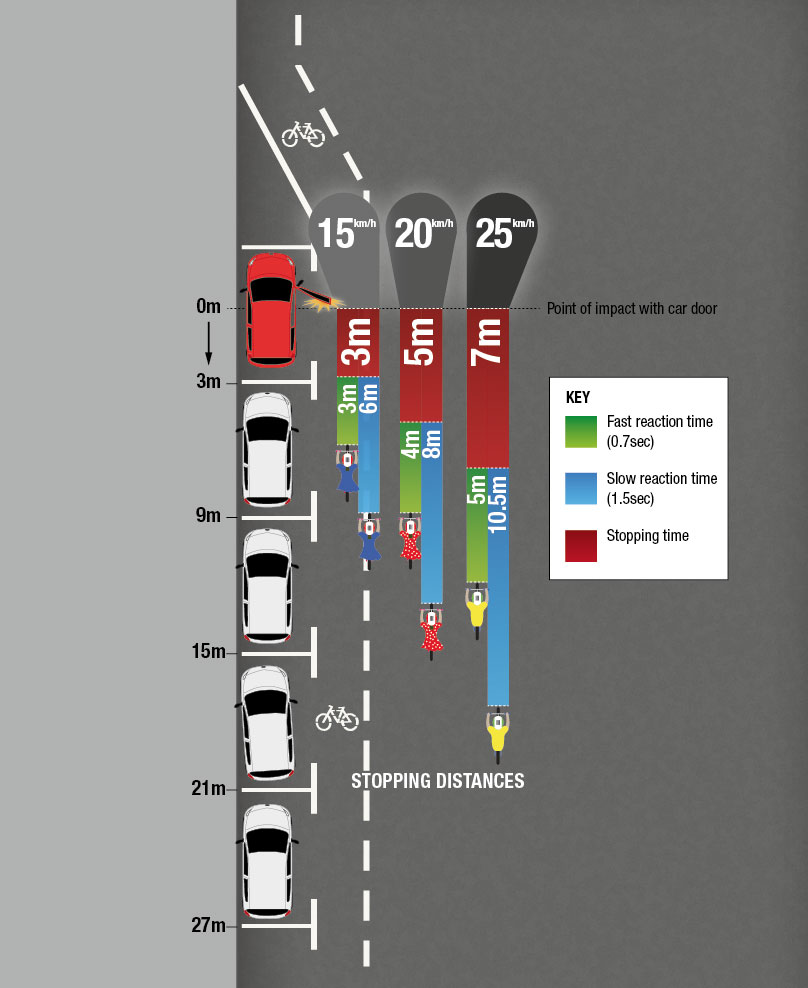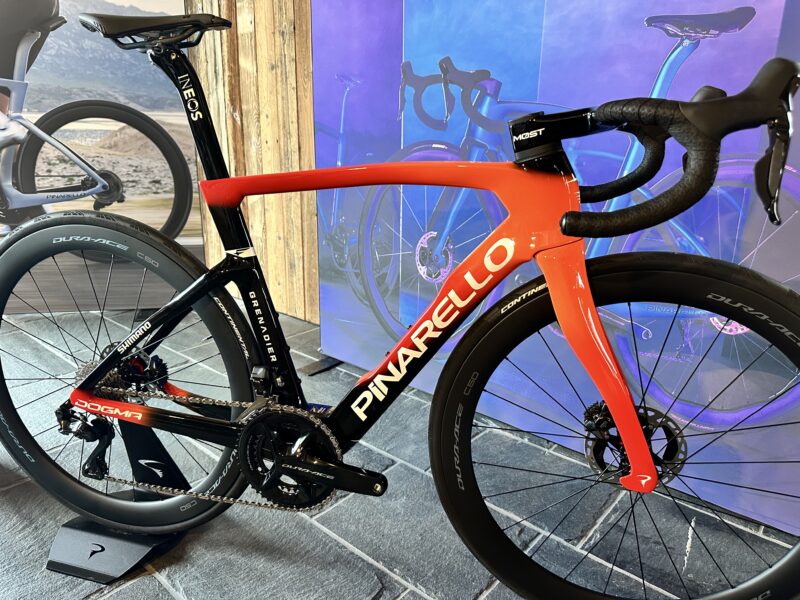Stay or go?
Will you make it across that intersection? Past that rider? Avoid that car door? Stephen Huntley takes a calculated look at speed and braking distances.

You’re approaching a set of traffic lights that have been green for a while and you know that they must be due to change. If you’re not quite at the stop line as the light changes from green to amber, should you hard brake and risk pulling up inside the intersection, or keep going and hope you make it through before traffic gets the green light coming the other way?
It’s a tough call. Road regulations state you must stop on the amber light (called yellow in the regulations) as near as practical to, but before, the intersection’s stop line, but only if you can do so “safely”.
Braking point
So when is it safe to pull up, and when is it safer to go? To pull up in time, we need to take into account the speed you’re going at then work out braking distances.
Based on our charts for a flat, dry road, our braking measurements, and a presumption that you’re anticipating an amber light (reducing reaction time), at 15km/h, you’ll take 6m to stop, 20km/h you’ll take 9m, and at 25km/h you’ll take 12m. If you brake any closer to the stop line than these distances, you’ll probably run over it.
But according to the regulations, if you can’t safely halt before the stop line, it is okay to go over it, as long as you don’t enter the intersection proper; that is, you can legally pull up between the marked pedestrian lines.
Intersections vary in size, as do pedestrian crossing areas and the distance between the intersection and the stop line. We’ve taken a typical large CBD intersection with a bike box as an example (corner of Bourke and Russell Streets, Melbourne, heading east). At this intersection the bike stop line is 4m short of the intersection.
Make a go of it
So what happens if, rather than brake, you decide to go? The timing of an amber light is determined by the marked speed limit. Following the amber there is an all-red period, giving vehicles in the intersection extra time to get clear.
In our intersection there is three seconds (s) of amber and 3.5s of all-red. You need to travel about 32m from the bike stop line to clear the intersection. This distance will see your rear wheel over the first line of the pedestrian crossing. While this gets you out of danger, you are still potentially obstructing pedestrians.

If you hit the stop line as the lights turn amber and you keep going, at 15km/h you’d be less than halfway across when the lights switched to all-red, and you’d be left hanging 5m short of clearing the intersection when the lights against you turned green (a very dangerous position to be in, particularly with cars doing hook turns).
At 20km/h you’d be halfway across when the lights turned from amber to all-red, but you’d just make it out of the intersection before they change to green.
Going at 25km/h, you’d be 11m short when the lights went from amber to all-red, but you’d be safely across by about 13m before they turn green.
What’s the lesson?
At this intersection, going at 15km/h you are vulnerable. If you are within 2m of the stop line when the lights turn amber, stopping or going could both leave you out in the intersection. You’re probably best to anticipate the impending light change well in advance (look for the flashing red of the opposite pedestrian crossing as a guide) and slow down to a crawl, so you can stop in time.
At 20km/h, you’re also vulnerable if the lights turn amber and you’re within 5m of the bike stop line. Try and anticipate the lights and drop your speed way down, or speed up.
At 25km/h, if you’re more than 10m from the stop line, brake. Closer than this, if you keep going you’ll make it across, but you’ll possibly be only part way through the intersection when the lights turn all-red, making the last section of the traverse a panic ride.
Remember, this advice is for this intersection only. Use our charts to help determine how to negotiate your regular intersections.
Door to door
What do our braking figures tell us about reacting to car doors? If you’re actively looking for car doors about to open, your reaction time before braking should be about 0.7s. If you’re riding along not thinking about it and a door opens, it’s more likely to be about 1.5s.
If you’re riding at 15km/h on a flat road and alertly looking for doors, if one is flung open you’ll make a safe stop if you’re 6m or more away (about the length of a parking bay; that is, you’d need to be next to the equivalent door parked one bay back). If you’re not alert you’ll have to be at least 9m away.
At 20km/h, being alert you’ll need to be more than 9m to brake in time. If you’re not paying attention, you will need to be at least 13m away.
At 25km/h and alert, you’ll need to be more than 12m away. If you’re not actively looking you’ll need to be at least 17.5m; almost three car bays back, and a substantial distance to both see, and be seen.

Reaction times can also be over 1.5s, pushing those braking distances out even further. Road engineers assume a reaction time of 2.5s, which 90% of the driving population is meant to be able to react under, but some studies have shown that many people take 3s or more to react in some driving situations.
The lesson here is that if you’re riding through an area where the probability of doors opening in front of you is high, slow down and be hyper-alert.
Head down
While riding, a glance away from the road ahead to check on equipment, make a quick adjustment, look at something to the side of the road/path, or become more aerodynamic, can be dangerous. In a two-second lookaway, going at 15km/h you’ll travel over 8m. At 25km/h you’ll cover 14m. What if you then looked up, saw a situation, and had to brake suddenly? Riding at 15km/h, you’d need 17m in total of clear road/path ahead to take account of this possibility. At 25km/h you’d need a clear 31m of road/path ahead of you.
Overtaking
You’re behind someone doing 15km/h and you want to pass. You crank it up to 20km/h, pull wide and go for it. It will take you about 7s in total to get safely ahead and pull back into the line, and you’ll be almost 40m up the road from where you started to pass.
What if this is a path, and there’s a possibility of someone riding towards you from the opposite direction? If they are also going 20km/h, you’d have to start the move when they were about 90m away to get around and back in a responsible way. You should also allow for a similar distance from a blind bend before overtaking at these speeds.
It will take the same time (7s) to overtake anyone if you pass at 5km/h faster than them. The difference is, if they’re doing 20km/h and you pass at 25km/h, in those 7s you’ll have travelled almost 50m. At 30km/h you’ll travel almost 60m.

Stopping distances
| Speed | React 0.7s | React 1.5s | Brake | Total0.7s | Total 1.5s |
| 10km/h | 2m | 4m | 1.5m | 3.5m | 5.5m |
| 15km/h | 3m | 6m | 3m | 6m | 9m |
| 20km/h | 4m | 8m | 5m | 9m | 13m |
| 25km/h | 5m | 10.5m | 7m | 12m | 17.5m |
| 30km/h | 6m | 12.5m | 9m | 15m | 21.5m |
| 35km/h | 7m | 14.5m | 11m | 18m | 25.5m |
| 40km/h | 8m | 16.5m | 15m | 23m | 31.5m |
| 45km/h | 9m | 19m | 19m | 28m | 38m |
Note: There is no standard formula for bike braking distances. Brake distance will vary between riders, bikes, braking systems, tyres and conditions. We measured the controlled braking distance of a competent rider on a road bike with dual-pivot rim brakes on a dry, flat tarmac surface. Cars will generally stop faster than bikes due to their more efficient brakes and lower centre of gravity.
How far you travel per second
| Speed | Distance travelled per second |
| 10km/h | 2.78m |
| 15km/h | 4.17m |
| 20km/h | 5.56m |
| 25km/h | 6.94m |
| 30km/h | 8.33m |
| 35km/h | 9.72m |
| 40km/h | 11.11m |
| 45km/h | 12.5m |
Amber time
| Prevailing speed limit | Amber time |
| 45km/h | 3s |
| 50km/h | 3.5s |
| 60km/h | 4s |
| 70km/h | 4.5s |
| 80km/h | 4.5s |
| 90km/h | 5s |
Note: Following the amber light there will be an all-red light to ensure vehicles clear the intersection. The formula for working this out is R=3.6W/V where R is the all red time in seconds, W is the width of the intersection in metres, and V is the posted vehicle speed. So, for instance, a big intersection with a 70km/h limit could have an amber time of 4.5s and an all-red time of 1.5s. The same intersection with a 45km/h limit could have a 3s amber and 3s all-red time.
Ride On content is editorially independent, but is supported financially by members of Bicycle Network. If you enjoy our articles and want to support the future publication of high-quality content, please consider helping out by becoming a member.








Hi, this is a really great article and a very valuable read. One thing that hasn’t been covered in the choice to go or stop, is the traffic around you. Cars (predictably) like to try and get through the amber lights so will speed up to do so. One thing i find, is that it is often safer to keep going, as if i stop then it potentially gives the car behind me less room to stop and i can stop in a shorter distance to them typically. I often find it dangerous to stop on the amber if there is not a lot of room for the cars to travel in their lanes.
Cheers
Traffic lights are coordinated for motorized vehicles moving at the speed limit – surprise, surprise. So much for the “Wipe Off Five” campaign, but I guess it’s a good excuse for all those car drivers I see running red lights on a daily basis.